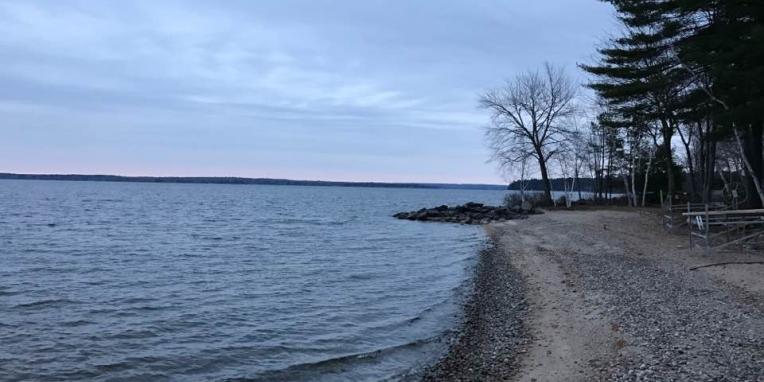Shoreland Ordinance Section 16
Administration
A. Administering Bodies and Agents
1. Code Enforcement Officer
A Code Enforcement Officer shall be appointed or reappointed annually by
July 1st.
2. Board of Appeals
A Board of Appeals shall be created in accordance with the provisions of
30-A M.R.S.A. section 2691.
3. Planning Board
A Planning Board shall be created in accordance with the provisions of
State Law.
B. Permits Required
After the effective date of this Ordinance no person shall, without first obtaining a
permit, engage in any activity or use of land or structure requiring permit in the
district in which such activity or use would occur; or expand, change, or replace an
existing use or structure; or renew a discontinued non-conforming use. A person
who is issued a permit pursuant to this Ordinance shall have a copy of the permit on
site while the work authorized by the permit is performed.
1. A permit is not required for the replacement of an existing road culvert as
long as:
a. The replacement culvert is not more than twenty-five (25%) percent
longer than the culvert being replaced;
b. The replacement culvert is not longer than seventy-five (75) feet; and
c. Adequate erosion control measures are taken to prevent
sedimentation of the water, and the crossing does not block fish
passage in the water-course.
2. A permit is not required for an archaeological excavation as long as the
excavation is conducted by an archaeologist listed on the State Historic
Preservation Officer’s level 1 or level 2 approved list, and unreasonable
erosion and sedimentation is prevented by means of adequate and timely
temporary and permanent stabilization measures.
3. Any permit required by this Ordinance shall be in addition to any other
permit required by other law or ordinance.
C. Permit Application
1. Every applicant for a permit shall submit a written application, including a
scaled site plan, on a form provided by the municipality, to the appropriate
official as indicated in Section 14.
2. All applications shall be signed by an owner or individual who can show
evidence of right, title or interest in the property or by an agent
representative, tenant, or contractor of the owner with authorization from
the owner to apply for a permit hereunder, certifying that the information in
the application is complete and correct.
3. All applications shall be dated, and the Code Enforcement Officer or
Planning Board, as appropriate, shall note upon each application the date
and time of its receipt.
4. If the property is not served by a public sewer, a valid plumbing permit, or
a completed application for a plumbing permit, including the site evaluation
approved by the Plumbing Inspector, shall be submitted whenever the
nature of the proposed structure or use would require the installation of a
subsurface sewage disposal system.
D. Procedure for Administering Permits
Within thirty-five (35) days of the date of receiving a written application, the
Planning Board or Code Enforcement Officer, as indicated in Section 14, shall notify
the applicant in writing either that the application is a complete application, or, if the
application is incomplete, that specified additional material is needed to make the
application complete. The Planning Board or the Code Enforcement Officer, as
appropriate, shall approve, approve with conditions, or deny all permit applications in
writing within thirty-five (35) days of receiving a completed application. However, if
the Planning Board has a waiting list of applications, a decision on the application
shall occur within thirty-five (35) days after the first available date on the Planning
Board’s agenda following receipt of the completed application, or within thirty-five
(35) days of the public hearing, if the proposed use or structure is found to be in
conformance with the purposes and provisions of this Ordinance.
The applicant shall have the burden of proving that the proposed land use activity is in conformity with the purposes and provisions of this Ordinance.
After the submission of a complete application to the Planning Board, the Board shall approve an application or approve it with conditions if it makes a positive finding based on the information presented that the proposed use:
1. Will maintain safe and healthful conditions;
2. Will not result in water pollution, erosion, or sedimentation
to surface waters;
3. Will adequately provide for the disposal of all waste water;
4. Will not have an adverse impact on spawning grounds, fish,
aquatic life, bird or other wildlife habitat;
5. Will conserve shore cover and visual, as well as actual, points of
access to inland waters.
6. Will protect archaeological and historic resources as designated in
the comprehensive plan;
7. Will avoid problems associated with flood-plain development and
use; and
8. Is in conformance with the provisions of Section 15, Land Use
Standards.
If a permit is either denied or approved with conditions, the reasons as well as conditions
shall be stated in writing. No approval shall be granted for an application involving a
structure if the structure would be located in an unapproved subdivision or would violate any other local ordinance, or regulation or statute administered by the municipality.
E. Special Exceptions
In addition to the criteria specified in Section 16(D) above, excepting structure
setback requirements, the Planning Board may approve a permit for a single family
residential structure in a Resource Protection District provided that the applicant
demonstrates that all of the following conditions are met:
1. There is no location on the property, other than a location within the Resource
Protection District, where the structure can be built.
2. The lot on which the structure is proposed is undeveloped and was established and
recorded in the registry of deeds of the county in which the lot is located before
the adoption of the Resource Protection District.
3. All proposed buildings, sewage disposal systems and other improvements are:
a. Located on natural ground slopes of less than twenty (20%) percent;
and
b. Located outside the floodway of the 100-year flood-plain along rivers
and artificially formed great ponds along rivers and outside velocity
zone in areas subject to tides, based on detailed flood insurance studies
and as delineated on the Federal Emergency Management Agency’s
Flood Boundary and Floodway Maps and Flood Insurance Rate Maps;
all buildings, including basements, are elevated at least one foot above
the one hundred (100) year flood-plain elevation; and the development
is otherwise in compliance with any applicable municipal flood-plain
ordinance.
If the floodway is not shown on the Federal Emergency Management
Agency Maps, it is deemed to be one half (½) the width of the one
hundred (100) year flood-plain.
4. The total ground-floor area, including cantilevered or similar overhanging
extensions, of all principal and accessory structures is limited to a maximum of
fifteen hundred (1,500) square feet. This limitation shall not be altered by
variance.
5. All structures, except functionally water-dependent structures, are set back from
the normal high-water line of a water body, tributary stream or upland edge of a
wetland to the greatest practical extent, but not less than seventy-five (75) feet,
horizontal distance. In determining the greatest practical extent, the Planning
Board shall consider the depth of the lot, the slope of the land, the potential for
soil erosion, the type and amount of vegetation to be removed, the proposed
building site’s elevation in regard to the flood-plain, and its proximity to
moderate-value and high-value wetlands.
F. Expiration of Permit
Permits shall expire one year from the date of issuance if substantial start is not made
in construction or in the use of the property during that period. If a substantial start is
made within one year of the issuance of the permit, the applicant shall have one
additional year to complete the project, at which time the permit shall expire.
G. Installation of Public Utility Service
A public utility, water district, sanitary district or any utility company of any kind
may install services to any new structure located in the shoreland zone unless written
authorization attesting to the validity and currency of all local permits required under
this or any previous Ordinance has been issued by the appropriate municipal officials
or other written arrangements have been made between the municipal officials and
the utility.
H. Board of Appeals
1. Powers and Duties of the Board of Appeals. The Board of Appeals shall have
the following powers:
a. Administrative Appeals:
To hear and decide administrative appeals, on an appellate basis, where it
is alleged by an aggrieved party that there is an error in any order,
requirement, decision, or determination made by, or failure to act by
the Planning Board in the administration of this Ordinance; and to hear and
decide administrative appeals on a de novo basis where it is alleged by an
aggrieved party that there is an error in any order, requirement, decision or
determination made by, or failure to act by, the Code Enforcement Officer
in his/her review of and action on a permit application under this Ordinance.
Any order, requirement, decision or determination made, or failure to act, in
the enforcement of this ordinance is not appeal-able to the Board of Appeals.
b. Variance Appeals:
To authorize variances upon appeal, within the limitations set forth in this
Ordinance.
2. Variance Appeals
Variances may be granted only under the following conditions:
a. Variances may be granted only from dimensional requirements including, but not limited to, lot width, structure height, percent of lot coverage, and setback requirements.
b. Variances shall not be granted for establishment of any uses otherwise prohibited by this Ordinance.
c. The Board shall not grant a variance unless it finds that:
i. The proposed structure or use would meet the provisions of Section 15 except for the specific provision which has created the non-conformity and from which relief is sought; and
ii. The strict application of the terms of this Ordinance would result in undue hardship.
The term “undue hardship” shall mean:
a. That the land in question cannot yield a reasonable
return unless a variance is granted;
b. That the need for a variance is due to the unique
circumstances of the property and not to the
general conditions in the neighborhood;
c. That the granting of a variance will not alter the
essential character of the locality; and
d. That the hardship is not the result of action taken by
the applicant or a prior owner.
d. Notwithstanding Section 16(H)(2)(c)(ii) above, the Board of Appeals may grant a variance to an owner of a residential dwelling for the purpose of making that dwelling accessible to a person with a disability who resides in or regularly uses the dwelling. The board shall restrict any variance granted under this subsection solely to the installation of equipment or the construction of structures necessary for access to or egress from the dwelling by the person with the disability. The board may impose conditions on the variance, including limiting the variance to the duration of the disability or to the time that the person with the disability lives in the dwelling. The term “structures necessary for access to or egress from the dwelling” shall include railing, wall or roof systems necessary for the safety or effectiveness of the structure.
e. The Board of Appeals shall limit any variances granted as
strictly as possible in order to ensure conformance with the purposes and provisions of this Ordinance to the greatest extent
possible, and in doing so may impose such conditions to a
variance as it deems necessary. The party receiving the
variance shall comply with any conditions imposed.
f. A copy of each variance request, including the application and all
supporting information supplied by the applicant, shall be forwarded by the municipal officials to the Commissioner of the Department of Environmental Protection at least twenty (20) days prior to action by the Board of Appeals. Any comments received from the Commissioner prior to action by the Board of Appeals shall be made part of the record and shall be taken into consideration by the Board of Appeals.
g. A copy of all variances granted by the Board of Appeals
shall be submitted to the Department of Environmental
Protection within fourteen (14) days of the decision.
h. Pursuant to 30 M.R.S.A. 4392, the certificate of Variance
Approval granted by the Board shall be registered at the
Registry of Deeds within ninety (90) days after the date of
the decision. Failure to register the certificate within that
time will cause the variance to be invalid. Proof of registration
shall be required prior to the issuance of a building permit.
3. Administrative Appeals
When the Board of Appeals reviews a decision of the Code Enforcement Officer, the Board of Appeals shall hold a “de novo” hearing. At this time the Board may receive and consider new evidence and testimony, be it oral or written. When acting in a “de novo” capacity the Board of Appeals shall hear and decide the matter afresh, undertaking its own independent analysis of evidence and the law, and reaching its own decision.
When the Board of Appeals hears a decision of the Planning Board, it shall hold an appellate hearing, and may reverse the decision of the Planning Board only upon finding that the decision was contrary to specific provisions of the Ordinance or contrary to the facts presented to the Planning Board. The Board of Appeals may only review the record of the proceedings before the Planning Board. The Board of Appeals shall not receive or consider any evidence which was not presented to the Planning Board, but the Board of Appeals may receive and consider written or oral arguments. If the Board of Appeals determines that the record of the Planning Board proceedings are inadequate, the Board of Appeals may remand the matter to the Planning Board for additional fact finding.
4. Appeal Procedure
1. Making an Appeal
i. An administrative or variance appeal may be taken to the Board of
Appeals by an aggrieved party from any decision of the Code
Enforcement Officer or the Planning Board, except for enforcement
related matters as described in Section 16(H)(1)(a) above. Such an
appeal shall be taken within thirty (30) days of the date of the official,
written decision appealed from, and not otherwise, except that the
Board, upon a showing of good cause, may waive the thirty (30) day
requirement.
ii. Applications for appeals shall be made by filing with the Board of
Appeals a written notice of appeal which includes:
a. A concise written statement indicating what relief is requested
and why the appeal or variance should be granted.
b. A sketch drawn to scale showing lot lines, location of existing
buildings and structures and other physical features of the lot
pertinent to the relief sought.
iii. Upon receiving an application for an administrative appeal or a
variance, the Code Enforcement Officer or Planning Board, as
appropriate, shall transmit to the Board of Appeals all of the papers
constituting the record of the decision appealed from.
iv. The Board of Appeals shall hold a public hearing on an administrative
appeal or a request for a variance within thirty-five (35) days of its
receipt of a complete written application, unless this time period is
extended by the parties.
2. Decision by Board of Appeals
i. A majority of the full voting membership of the Board shall constitute a
quorum for the purpose of deciding an appeal.
ii. The person filing the appeal shall have the burden of proof.
iii. The Board shall decide all administrative appeals and variance appeals
within thirty-five (35) days after the close of the hearing, and shall issue
a written decision on all appeals.
iv. The Board of Appeals shall state the reasons and basis for its decision,
including a statement of the facts found and conclusions reached by the
Board. The Board shall cause written notice of its decision to be mailed
or hand-delivered to the applicant and to the Department of
Environmental Protection within seven (7) days of the Board’s decision.
Copies of written decisions of the Board of Appeals shall be given to
the Planning Board, Code Enforcement Officer, and the municipal
officers.
5. Appeal to Superior Court
Except as provided by 30-A M.R.S.A. section 2691(3)(F), any aggrieved party
who participated as a party during the proceedings before the Board of
Appeals may take an appeal to Superior Court in accordance with State laws
within forty-five (45) days from the date of any decision of the Board of
Appeals.
6. Reconsideration
In accordance with 30-A M.R.S.A. section 2691(3)(F), the Board of Appeals
may reconsider any decision within forty-five (45) days of its prior decision.
A request to the Board to reconsider a decision must be filed within ten (10)
days of the decision that is being reconsidered. A vote to reconsider and the
action taken on that reconsideration must occur and be completed within forty-
five (45) days of the date of the vote on the original decision. Reconsideration
of a decision shall require a positive vote of the majority of the Board
members originally voting on the decision, and proper notification to the
landowner, petitioner, Planning Board, Code Enforcement Officer, and other
parties of interest, including abutters and those who testified at the original
hearing(s). The Board may conduct additional hearings and receive additional
evidence and testimony.
Appeal of a reconsidered decision to Superior court must be made within
fifteen (15) days after the decision on reconsideration.
I. Enforcement
1. Nuisances
Any violation of this Ordinance shall be deemed to be a nuisance.
2. Code Enforcement Officer
a. It shall be the duty of the Code Enforcement Officer to enforce the provisions of this Ordinance. If the Code Enforcement Officer shall find that any provision of this Ordinance is being violated, he/she shall notify in writing the person responsible for such violation, indicating the nature of the violation and ordering the action necessary to correct it, including discontinuance of illegal use of land, buildings or structures, or work being done, removal of illegal buildings or structures, and abatement of nuisance conditions. A copy of such notices shall be submitted to the municipal officers and be maintained as a permanent record.
b. The Code Enforcement Officer shall conduct on-site inspections to insure compliance with all applicable laws and conditions attached to permit approvals. The Code Enforcement Officer shall also investigate all complaints of alleged violations of this Ordinance.
c. The Code Enforcement Officer shall keep a complete record of all essential transactions of the office, including applications submitted, permits granted or denied, variances granted or denied, revocation actions, revocation of permits, appeals, court actions, violations investigated, violations found, and fees collected. On a biennial basis, a summary of this record shall be submitted to the Director of the Bureau of Land and Water Quality within the Department of Environmental Protection.
3. Legal Actions
When the above action does not result in the correction or abatement of the violation or nuisance condition, the Municipal Officers, upon notice from the Code Enforcement Officer, are hereby directed to institute any and all actions and proceedings, either legal or equitable, including seeking injunctions of violations and the imposition of fines, that may be appropriate or necessary to enforce the provisions of this Ordinance in the name of the municipality. The municipal officers, or their authorized agent, are hereby authorized to enter into administrative consent agreements for the purpose of eliminating violations of this Ordinance and recovering fines without Court action. Such agreements shall not allow an illegal structure or use to continue unless there is clear and convincing evidence that the illegal structure or use was constructed or conducted as a direct result of erroneous advice given by an authorized municipal official and there is no evidence that the owner acted in bad faith, or unless the removal of the structure or use will result in a threat or hazard to public health and safety or will result in substantial environmental damage.
4. Fines
Any person, including but not limited to a landowner, a landowner’s agent or a contractor, who violates any provision or requirement of this Ordinance shall be penalized in accordance with 30-A, M.R.S.A. section 4452.
NOTE: Current penalties include fines of not less than one hundred ($100) dollars nor more than twenty-five hundred ($2500) dollars per violation for each day that the violation continues. However, in a Resource Protection District the maximum penalty is increased to five thousand ($5000) dollars (38 M.R.S.A.
section 4452).






